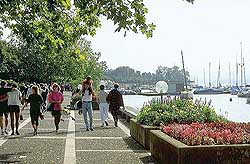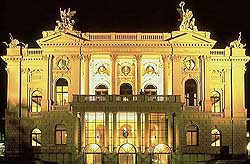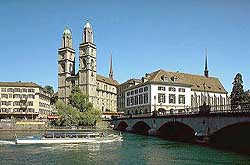


 |


|
|
| |
 Zurich is one of the most beautiful cities in Europe, and it is well
worth your time to spend a day or two
taking in its pleasures.
Zurich is one of the most beautiful cities in Europe, and it is well
worth your time to spend a day or two
taking in its pleasures. The city of Zurich was established as a Roman customs post (called "Turicum") in 15 B.C. It is situated some 400 metres (1,340 ft) above sea level at the northern end of the 27 km (17 miles) long Lake of Zurich. Its well-preserved Old Town is to be found on both banks of the River Limmat, which flows out of the lake in a northerly direction. With a population of some 336,000 inhabitants, Zurich is the largest city in Switzerland. It is surprisingly compact, though, with a wealth of old churches, fountains, and cobbled streets with buildings, some of them more than 700 years old, housing charming galleries and small shops.
 Zurich's reputation as a shopping paradise and an art centre which
is home to highly renowned auction houses has done much to make the city
known throughout the world. The main shopping area is concentrated within one
square kilometre in the heart of the city, which means it is easily covered on
foot. Strolling down the famous Bahnhofstrasse - one of the most
beautiful shopping streets in Europe - you will find elegant boutiques,
department stores, specialist shops, banks, and cafés which tempt you to
linger and relax for a while.
Zurich's reputation as a shopping paradise and an art centre which
is home to highly renowned auction houses has done much to make the city
known throughout the world. The main shopping area is concentrated within one
square kilometre in the heart of the city, which means it is easily covered on
foot. Strolling down the famous Bahnhofstrasse - one of the most
beautiful shopping streets in Europe - you will find elegant boutiques,
department stores, specialist shops, banks, and cafés which tempt you to
linger and relax for a while.
 The pedestrian streets of the Old Town contain most of the major sights,
including winding alleyways, 16th and 17th-century houses, guildhalls and
churches. The 13th-century tower of St Peter's Church has the largest
clock face in Europe, while the Fraumünster Church nearby is noted
for the distinctive stained-glass windows in the choir, which were created by
Marc Chagall in 1970. The cities most famous landmark is the
Grossmünster with its unique dual towers. Believed to be of
Carolingian origin, its oldest parts date back to the late 11th century.
The pedestrian streets of the Old Town contain most of the major sights,
including winding alleyways, 16th and 17th-century houses, guildhalls and
churches. The 13th-century tower of St Peter's Church has the largest
clock face in Europe, while the Fraumünster Church nearby is noted
for the distinctive stained-glass windows in the choir, which were created by
Marc Chagall in 1970. The cities most famous landmark is the
Grossmünster with its unique dual towers. Believed to be of
Carolingian origin, its oldest parts date back to the late 11th century.
 The "Kunsthaus" (the Zurich Art Gallery) is Zurich's top address for
art. It has paintings, sculptures and graphic art, mostly from the 19th &
20th centuries.
The Museum of Fine Arts has a large permanent collection ranging from
15th-century religious art to the `modern' art of Monet, Manet and Man Ray. The
Swiss National Museum offers a permanent collect on Swiss national
history and is housed north of the city centre just next to the Main Railway
Station (which dates back to 1871). The Arboretum and Quayside
Park offer amply laid-out waterfront paths along the the shores of Lake
Zurich which pass picnic, sunbathing and swimming spots.
The "Kunsthaus" (the Zurich Art Gallery) is Zurich's top address for
art. It has paintings, sculptures and graphic art, mostly from the 19th &
20th centuries.
The Museum of Fine Arts has a large permanent collection ranging from
15th-century religious art to the `modern' art of Monet, Manet and Man Ray. The
Swiss National Museum offers a permanent collect on Swiss national
history and is housed north of the city centre just next to the Main Railway
Station (which dates back to 1871). The Arboretum and Quayside
Park offer amply laid-out waterfront paths along the the shores of Lake
Zurich which pass picnic, sunbathing and swimming spots.
Zurich is also an ideal departure point for excursions all over
Switzerland. You can easily travel to the Rhine Waterfalls, to Lucerne, or to
the Säntis or Rigi mountains and back to Zurich in just half a day.
Whole-day trips by train or coach will take you to the Ticino, Graubünden,
up the Titlis mountain or to the never-melting snow and ice on the
Jungfraujoch, or even across the border to Austria, Italy or Germany.
You will have the opportunity to sign up for a variety of guided tours at the
symposium -- be sure to plan an extra day or two after the conference to enjoy
some of Switzerlands most beautiful sights!
[text courtesy of Lonely Planet and Zurich Tourism, pictures courtesy of Zuerich.ch]
Over a thousand trains halt daily at Zurich's centrally located main railway station. Direct and frequent services to all the large Swiss cities as well as major European destinations ensure a pleasant journey. You can find detailed connection information in the Swiss Federal Railway timetable.
Zurich's Public Transport System operates a comprehensive, modern tram and bus network. Vehicles run daily between 5.15 am and midnight, with services every six minutes during rush hours. Tickets offer unlimited travel on public transport within the corresponding zones and time period. Detours, return journeys and stop-offs are allowed, and you may also change lines or modes of transport. See the Symposium Location Page for street and tram maps, as well as detailed directions to the symposium venue.
Weather: With its geographical latitude of 47 degrees 23 minutes north, Zurich is only slightly closer to the north pole than to the equator. The climate is moderate with no excessive heat, cold or humidity. The average high in September is 19 degrees Celsius (65 degrees Fahrenheit), the average low 12 degrees Celsius (52 degrees Fahrenheit). For the latest weather forecast, check CNN's Weather Forecast or USA Today.
Currency: 1 Swiss Franc (CHF) is about 0.58 US Dollars, or 0.64 Euro (as of August 2000). For current exchange rates, see the Universal Currency Converter or Oanda.com, which offer detailed conversion tables, for example for US Dollar, Euro, or Japanese Yen. Coins in circulation are 5, 10, 20 and 50 Cents (1 Franc = 100 Cents), as well as 1, 2 and 5 Francs. Swiss bank notes come as 10, 20, 50, 100, 200, 500 and 1000 Francs bills.
Credit Cards: The most popular credit cards are Visa, MasterCard and American Express. Many banks in Switzerland have equipped their ATM machines with the CIRRUS® or MAESTRO® system, which allows you to use your American or Canadian bank card. Many Swiss banks also offer ATM machines for cash advances with your credit card. It is recommended to have a small amount of cash on hand upon arrival in Switzerland for immediate expenses, i.e. taxies, public transportation etc. (At the airport and the main railway station you find of course ATM machines and exchange offices.)
Passport/Visa: If your stay is shorter than three months you only need to bring your valid passport with you, a visa is not required. This applies to citizens of the following countries: countries of the American Continent, Europe, Japan, Australia and New Zealand. Exceptions may apply. For more detailed information on visas, please contact the Swiss Consulate General located nearest you (for the US, see the Embassy of Switzerland in the United States; in Japan, see the Visa page at Switzerland Tourism, Japan. Online information is also available from the Swiss Embassy in France, Great Britain and Korea.)
Tipping: Tips are automatically included in all hotel and restaurant bills and in most taxi fares. For special services like luggage handling, it is customary to tip CHF 2 per bag.
|
|
|